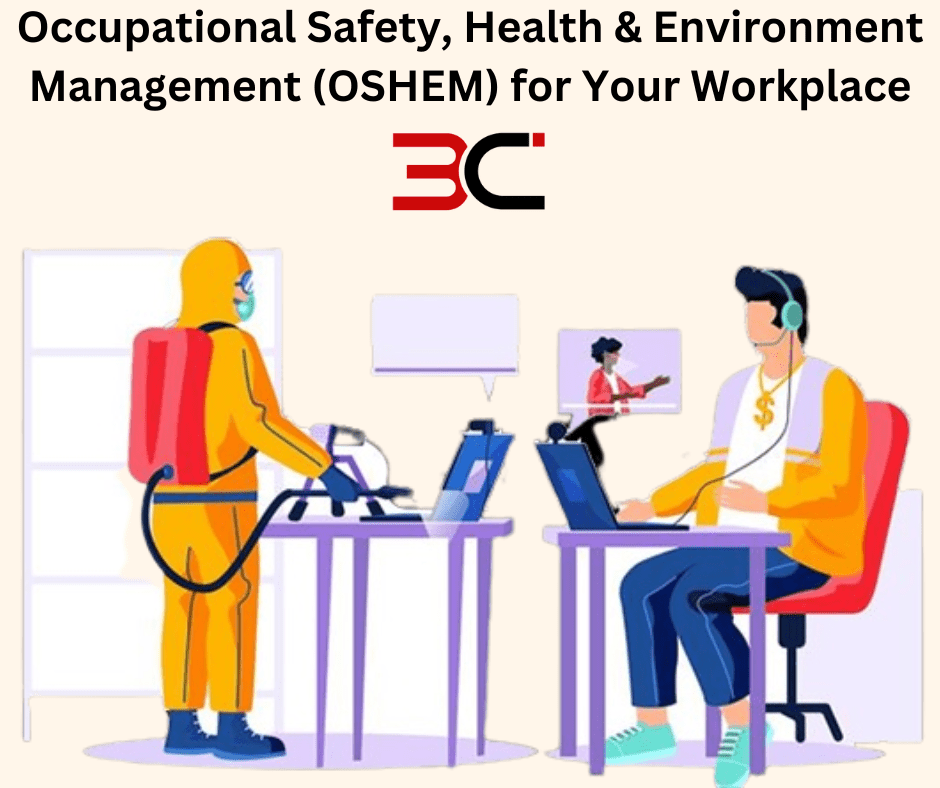The number of fatal occupational injuries per day is 14. An employee can take a total of 8 holidays on average at work because of health issues.
Try to limit the number of fatal workplace accidents, health issues that employees may experience at work, the generation of greenhouse gasses, and the caliber of your goods. By adhering to the Occupational Safety, Health, and Environment Management (OSHEM) framework, all of these may be properly handled at work.
Today, we will thoroughly go over the Safety Management Systems (SMS), Environmental Management Systems (EMS), Rail Safety Accreditation Schemes, Government Prequalification Schemes, and the HSEQ (Health, Safety, Environment, and Quality) framework.
Safety Management System (SMS)
An organization-wide set of standardized procedures is known as a Safety Management System (SMS). This enables making efficient choices to handle risks in everyday business activities. Systems for managing safety assist businesses in providing the greatest degree of safety in their goods and services, as well as in maintaining safe operations.
The International Civil Aviation Organization (ICAO) marked –
- Hazard analysis, accident investigation, risk mitigation, performance assessment, and quality assurance as the fundamental operations of the Safety Management System.
Additionally, SMS can be used to formally comply with legal requirements, such as Title 14 of the US Code of Federal Regulations (CFR), which is enforced by the Federal Aviation Administration (FAA).
The Components of SMS
The Safety Management System (SMS) is made up of four functional components.
- Safety Policy outlines the approaches, procedures, and organizational framework required to achieve safety objectives and confirms senior management’s commitment to continuously enhancing safety.
- With SMS, managerial commitment to safety performance is established.
- Defined safety goals and a commitment to managing those goals are established.
- Outlines the organizational structure, procedures, and techniques required to accomplish safety objectives.
- Creates transparency in the safety management process.
- Builds on the practices and methods currently in place.
- Encourages collaboration and communication between organizations.
- Safety Risk Management (SRM) – Based on the evaluation of tolerable risk, decides whether new or amended risk controls are necessary and adequate.
- The following are the elements of a formal SMS procedure:
- Assessing the risk
- Describing the system
- Controlling the risk
- Identifying the hazards
- Analyzing the risk
- The SRM procedure could be included in the procedures used to deliver the goods or services.
- Safety Assurance (SA) determines if current risk control techniques are still effective. It also encourages the discovery of fresh dangers.
- Functions of SMS strategic planning that are implemented consistently give assurance that organizational outputs meet or exceed safety criteria
- AVS SMS includes two different safety guarantees.
- Ensures adherence to SMS specifications and FAA orders, standards, policies, and directives.
- Existing assurance functions will keep assessing and enhancing the service.
- Analyzes and offers insight into potential ways to increase safety and reduce risk.
- Safety Promotion – It includes education, outreach, and other initiatives to establish a strong culture of safety at all levels of the organization.
- Activities that promote safety inside the SMS framework.
- Promoting safety is a collective responsibility.
The two main procedures of the SMS are Safety Assurance (SA) and Safety Risk Management (SRM). Additionally, they are quite engaging. The flowchart will show the interfaces between Safety Assurance (SA) and Safety Risk Management (SRM) –
Source: (faa.gov)
The Benefits of SMS
Here are some benefits of the Safety Management System (SMS) –
- Boost communication, staff reporting, and overall safety culture. Utilize timelines and discussions to improve communication and promote a culture of cooperation.
- Track and analyze SMS centrally for ongoing improvement. Every audit or inspection you do should be turned into a polished report that can be distributed.
- Streamline productivity in Safety Risk Management (SRM). You may quickly and effectively detect risky working situations, evaluate safety hazards, and implement control procedures.
Environmental Management System (EMS)
In order to execute environmental policies and comply with government regulations, a business might create an Environmental Management System (EMS) in line with the ISO 14001 standard.
The obligations outlined in the company’s policies are the main focus of an EMS’s resources. This policy could call for minimizing or doing away with the harmful effects of its activities, services, and goods on the environment.
The Components of EMS
The local, regional, and global environments are the EMS’s main clients. The Environmental Management System (EMS) consists of these three main components:
- Important auxiliary procedures include keeping abreast of regulatory requirements, assuring personnel competency, providing infrastructure, communicating EMS information, and monitoring and evaluating environmental performance.
- Processes like records control, document control, and internal audit are supported by management systems.
- Assessment of important environmental elements and impacts, as well as critical processes and associated outputs.
The Benefits of EMS
EMS offers plenty of advantages, which can be categorized according to general, economic, and organizational perspectives.
General
- Making sure to consider environmental issues holistically.
- Concentrating primarily on essential elements and procedures.
- Using established, time-tested methods that are widely accepted.
- Forming effective connections with regulators.
Economic
- Helps to maintain the reputation and image of the company.
- Costs and levies associated with the environment are modest.
- Expand your reach to potential clients.
- Savings is directly achieved by reducing environmental sources.
Organizational
- Technique for improving the quality and quantity of management systems.
- Unproven enhancement of a company’s standing or rapport with government regulators, neighborhood groups, or other stakeholders.
- Any change has a measurable cost savings or cost avoidance component.
Railway Safety Accreditation Scheme (RSAS)
The Railway Safety Accreditation Scheme (RSAS) enables people to certify workers of businesses engaged in rail safety and security, allowing officials to concentrate on their primary responsibilities.
This recognition program aids individuals in combating low-level crime and anti-social behavior, enhancing intellect, and boosting public trust.
Members of the RSAS
Several railroad businesses, security firms, and organizations are now accredited under the RSAS program. These members include –
- South Western and Eastern Rail
- Transport for London (TfL)
- Govia Thameslink Railway (GTR)
- Stambridge Group
- Amulet (both Northern Rail and C2C)
- Carlisle Security
- Maybank
- Black Diamond
The Benefits of RSAS
Here are some of the mentionable advantages of the RSAS scheme –
- Has a significant impact on lowering crime and raising passenger safety.
- An acknowledgment that businesses involved in railway security adhere to certain management, oversight, and accountability requirements.
- Certain difficulties can be resolved immediately by accredited workers without the participation of BTP.
- A better working environment for all those involved in providing railway safety patrols.
- Improved employee confidence because of great training
- Employee empowerment makes it simpler for them to perform well.
- The use of an emblem that is well recognized.
- Improved professional growth with new skills and variety for qualified individuals.
Government Prequalification Schemes
Contractors intending to tender for the construction of bridges and roads, pavement, specialty works, and supplies must pre-qualify via a Government Prequalification Scheme that is stated in the Intelligent Transport Systems (ITS).
The prequalification scheme’s objective is to categorize contractors based on their technical and management expertise, financial capability, and prior performance. The program’s objective is to make contract assessment and transportation security for specific projects easier, not to replace them.
Categories for Prequalification Schemes
Contractors may submit an application for a Government Prequalification Scheme in one or more of the following categories:
- Asphalt and Concrete Paving
- Steel Fabrication
- Bridgeworks
- Roadworks
- Pretensioned Concrete
- Traffic Signals
HSEQ (Health, Safety, Environment, & Quality)
The HSEQ framework represents a dedication to the well-being of employees, the preservation of the environment, and customer happiness. The framework consists of the following 4 aspects –
Health
Thanks to the health part of the HSEQ framework, you may create robust occupational health procedures, labor conditions, and activities that can either avoid or reduce the risk of injury to your employees.
Safety
The HSEQ framework will enable you to design processes that pinpoint workplace risks and implement stringent safety controls to lower accidents and exposure to hazardous situations and things.
Environment
This feature of the HSEQ framework gives you the ability to adhere to the advised environmental laws, which can help in lowering the company’s carbon impact.
Quality
In order to monitor, regulate, and regulate the quality of your goods or services, the HSEQ framework facilitates the development of quality management systems.
The Benefits of HSEQ
The HSEQ is a must for ensuring the safety and quality of the working environment. Here are some of the notable benefits –
- According to the HSEQ framework, you want to design and implement procedures that comply with standard health, safety, environment, and quality best practices.
- Put rules and procedures in place that guarantee a secure and healthy working environment.
- By creating quality control procedures inside the HSEQ framework, errors will be decreased.
- The requirements, rules, and laws will lessen the possibility of legal action.
- Employing the HSEQ framework will demonstrate to your clients, partners, and staff that your company values employee wellbeing.
Bottom Line
It is crucial to guarantee the safety and health of your staff. Both minimizing the environmental impact of your business and guaranteeing the high caliber of your goods and services are essential.
Therefore, include Occupational Safety, Health, and Environment Management (OSHEM) procedures in your workplace to provide a risk-free working environment.

